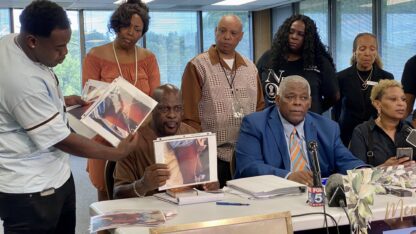
What are parks known for?
You might say a place to walk, run, relax or have an event.
To some, parks are also places to show off art. In some parts of the country, art has helped create and maintain a city’s national reputation. Atlanta hopes one of its recent acquisitions leads the city down that path.
Click here to listen to the story that aired on City Cafe 3/28/13
Freedom Park sits between Atlanta’s Poncey-Highland and Little Five Points neighborhoods. Inside the section of the park close to the corner of North and Euclid Avenues sits a three piece sculpture.
“This is the Tree of Life and the seats,” said Yvonne Domenge. She made the orange seats from carbon steel and the red tree from bronze. The Tree of Life is a lot smaller than the massive, cosmos inspired spheres the Mexico City born artist is known for.
“This is nature, which is the micro world,” said Domenge. “The small things. The beauty of something small.”
The Tree of Life sculpture is a permanent installation in Freedom Park. It came from Chicago’s Millennium Park.
“Millennium Park nationally is known as one of the best public art parks,” said Atlanta Parks and Cultural Affairs Commissioner George Dusenbury. He says some of the more than $400 million spent to build Millennium was used to acquire art for the park. Millennium Park was a temporary home for many of Domenge’s pieces. Once the decision was made to offer some of temporary pieces to other cities, Dusenbury says Atlanta knew it wanted the $80,000 Tree of Life sculpture for Freedom Park.
“The vision is basically you walk along and you see the permanent art pieces and this is a permanent art piece here,” said Dusenbury. “But also we’ll have pads where we’ll be able to do temporary art pieces too.”
Dusenbury says Atlanta considers Freedom Park its arts park. But, he says other parks including Butler, Woodruff and Cleopas R. Johnson also showcase artistic works.
“Whenever we do a project in a public park, we have to have art as part of that.”
He says the city designates at least 1.5% of the total cost of park related capital projects to art. Domenge calls showcasing her art in parks “the greatest joy”
“…because you share it,” said Domenge. “Because it becomes part of the people of their everyday life.”
She and Dusenbury hope the Tree of Life also influences more artists to have their works displayed in city parks.


9(MDAxODM0MDY4MDEyMTY4NDA3MzI3YjkzMw004))






